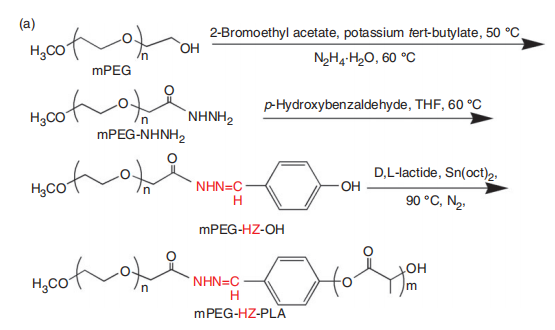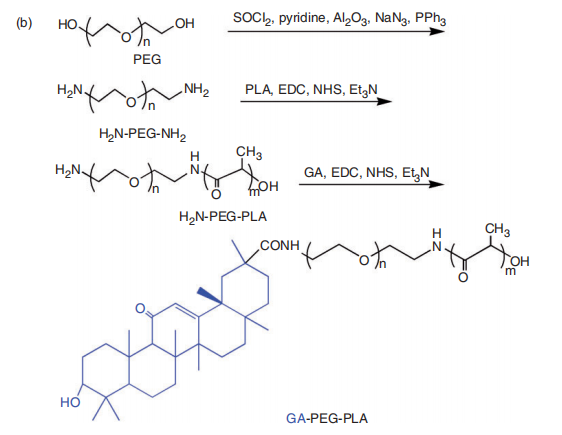文献:Targeted pharmacokinetics of polymeric micelles modified with glycyrrhetinic acid and hydrazone bond in H22 tumor-bearing mice
文献链接:https://pubmed.ncbi.nlm.nih.gov/30987507/
作者:Yan Zheng , Shudan Shi, Yaru Liu, Yandan Zhao andYuqi Sun
相关产品:
原文摘要:Liver cancer is one of the most common malignant tumors. Chemotherapy drugs have been widely used in the antihepatoma research. However, low targeting efficiency and serious adverse reaction are their main drawbacks. Liver tumor was proved to have a slightly acidic microenvironment (pH 4.5–5.5) and many glycyrrhetinic-acid-specific binding sites.Therefore, in the present study, the glycyrrhetinic acid- and hydrazone bond-modified micelles were designed. mPEG-HZ-PLA and GA-PEG-PLA copolymer were synthesized to prepareglycyrrhetinic-acid-modified pH-sensitive polymeric micelles (GA-PEG-HZ-PLA). The targeted pharmacokinetics was used to evaluate the effect in hepatoma 22 tumor-bearing mice after the micelles were administered intravenously. The contents of coumarin-6 in blood and tissues were determined through high-performance liquid chromatography using a fluorescence detection (HPLC-FLD) with coumarin-30 as inner standard. The micelles have shown long-circulation effects and two-department models. In the targeting pharmacokinetics, the relative intake efficiency, targeted efficiency, relative targeting efficiency, and concentration ratio of GA-PEG-HZ-PLA in the tumor were 3.24, 4.04, 3.00, and 2.47, respectively. We have demonstratedthat GA-PEG-HZ-PLA was more effectively accumulated in the liver and tumor. Thus, the prepared active-targeted and pH-sensitive micelles modified with glycyrrhetinic acid structure and hydrazone bond are promising tools for effective liver cancer therapy.
mPEG - PLA 结合了 PLA 的可降解性与 mPEG 的亲水性和生物相容性优势。PLA 可在生理环境下逐渐降解为乳酸,这使得该聚合物在化合物递送领域可作为化合物载体,通过控制 PLA 的分子量和比例来调节化合物释放速度。mPEG 部分能够减少聚合物在体内的非特异性吸附,延长其在体内的循环时间,提高化合物的利用效率,在生物医药、组织工程等领域有着应用前景,例如用于制备纳米化合物载等。 该文献研究设计了甘草次酸和肼键改性胶束。合成了mPEG-HZ-PLA和GA-PEG-PLA共聚物,制备了甘草酸改性的pH敏感聚合物胶束(GA-PEG-HZ-PLA)。过程如下:

图:mPEG-HZPLA共聚物过程
共聚物的合成
将mPEG - PLA溶解在DMF,加入适量的GA(戊二醛)和催化剂,如对甲苯磺酸(p - TsOH)。戊二醛的醛基可以与mPEG - PLA上的羟基或氨基(如果存在)发生反应,形成缩醛或席夫碱结构。反应通常在室温或适当的低温下进行,同时要在惰性气体(如氮气)保护下,以防止醛基被氧化。反应时间可能需要数小时至数天,具体取决于反应条件和反应物的浓度。通过薄层色谱(TLC)或其他分析方法监测反应进程,当mPEG - PLA上的部分官能团与GA反应完全后,得到中间产物GA - PEG - PLA。将GA - PEG - PLA中间产物通过旋转蒸发仪除去有机溶剂分离出来,然后重新溶解在PBS中,加入含有肼基的HZ(酰肼)化合物,酰肼的肼基与GA - PEG - PLA上的醛基发生反应,形成腙键。通过高效液相色谱(HPLC)监测反应,当醛基全部或大部分与肼基反应后,得到GA - PEG - HZ - PLA产物。反应结束后,采用透析的方法,使用合适截留分子量的透析袋,在去离子水中透析数天,除去小分子杂质。

图:GA-PEGPLA共聚物过程
结论:该文献研究成功合成了两种共聚物mPEG-HZ-PLA和GA-PEG-PLA,并将其用于制备了装载Cou6的混合聚合物胶束(GA-PEG-HZ-PLA)。采用HPLC-FLD法检测小鼠组织中Cou6的浓度。胶束可以延长化合物在体内中的循环。在TPK研究中,证实了GA-PEG-HZ-PLA比mPEG-PLA和mPEG-HZ-PLA在tumor中的积累更有效。

 2025-08-22 作者:ZJ 来源:
2025-08-22 作者:ZJ 来源:

